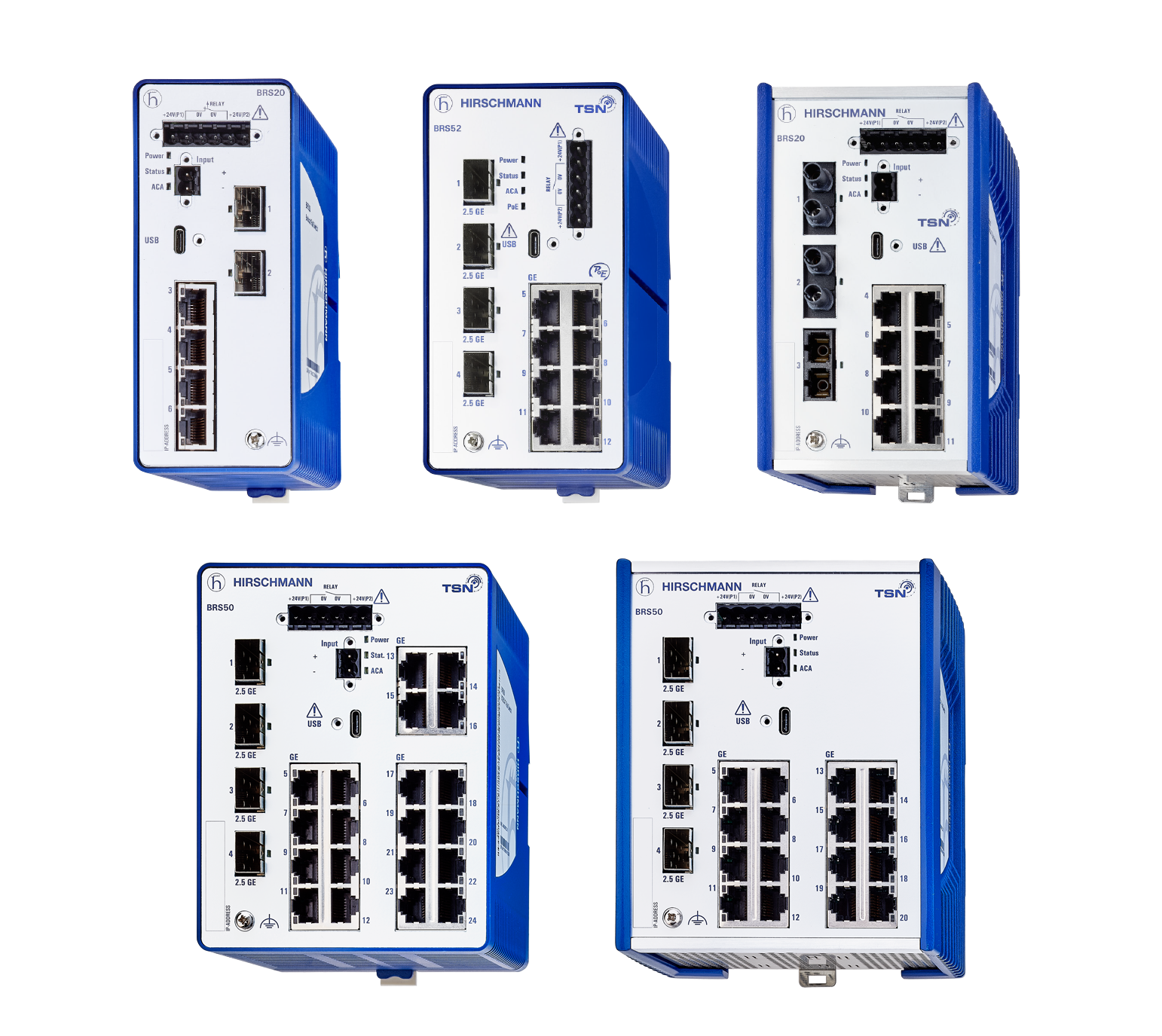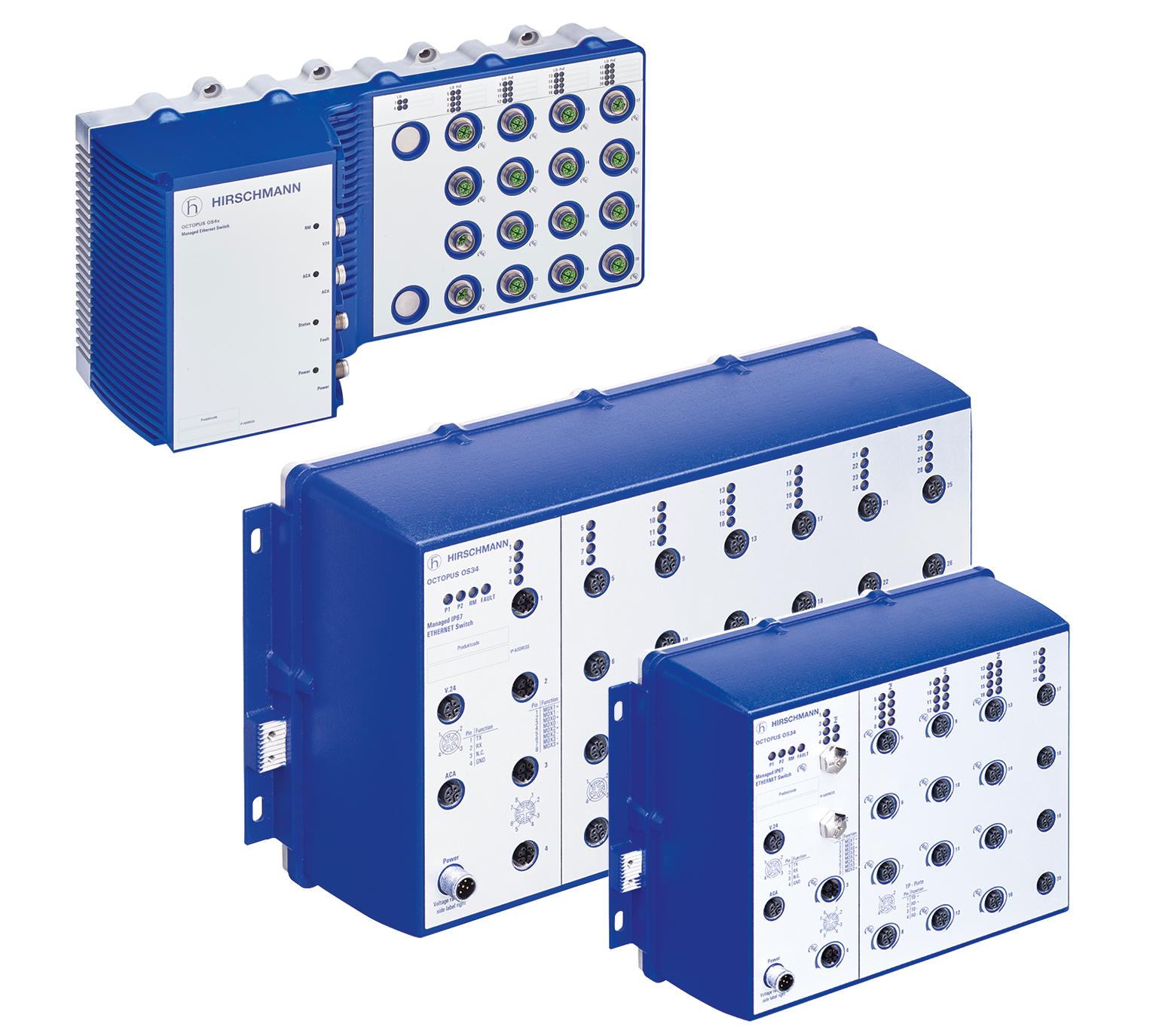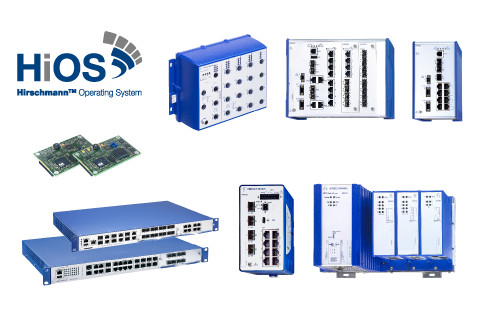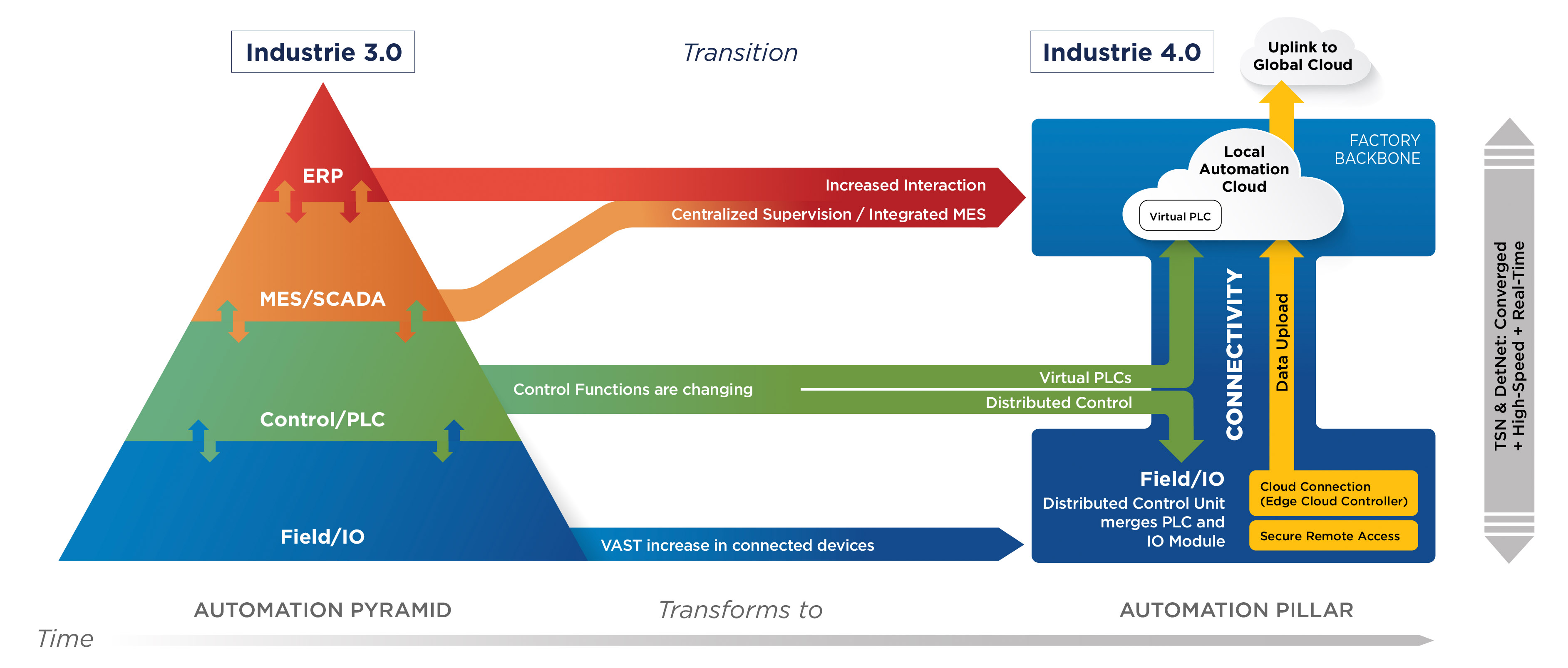TSN: Time Sensitive Networking
Driving Unification to Improve Cost and Performance
Time Sensitive Networking (TSN) is a technology that combines the large bandwidth capabilities of Ethernet with the determinism of a real-time fieldbus – all based on vendor-neutral standards specified by the IEEE 802.
-
Overview
-
Understanding TSN
-
Driving TSN Development
-
TSN Solutions
-
TSN Resources
-
FAQ
The incredible progress in machine intelligence and robotics in recent years has driven progress in automation, especially industrial automation and automotive control.
Explore How Automation Networks Are Changing
TSN offers many benefits to modern industrial automation networks by providing high bandwidth and reliable, dependable real-time communication.
Why TSN?
TSN can be leveraged for a variety of applications not only because of the technological advantages but also because of its lower total cost of ownership (TCO). You may have the added cost of replacing existing switches with TSN switches, but that typically costs less than duplicating networks and maintaining the additional networks.
In automation networks, TSN enables the convergence of numerous small, disconnected networks into one unified network structure. This new network can accommodate the requirements for real-time communication on a larger scale, while providing more transmission bandwidth for background data. Have a look at some use cases showing the benefits of network convergence in different markets.
Experience Our TSN Capable Portfolio
Belden is committed to furthering the TSN technology and deliver Industrial Ethernet switches with the highest possible quality standards. Explore our continuously expanding portfolio of TSN capable devices and software solutions ensuring reliable vendor independent communication.
-
DIN Rail Switches
-
IP67 Switches
-
Software
Hirschmann Managed Fast/Gigabit Ethernet Switches – RSPE Expandable

- Future-proof design and best-possible investment protection - thanks to the maximum flexibility provided by the media modules
- Maximum productivity for systems and machines - thanks to completely interruption-free data communication
- Future-proof interoperability – built-in PRP and HSR based on international IEC62439 standard
- Cost-effective solution – easy-to-add media modules and PoE/ PoE+ ports for a cost-efficient power supply of end devices
Hirschmann Next-Generation Compact Fast/Gigabit Ethernet Switches - BOBCAT

- Advanced security - including wire-speed access lists and automatic denial-of-service-prevention
- Precise data transmission - simultaneously support multiple services on the network through TSN technology
- Prepare for future growth - increased bandwidth and speed capabilities
- Increased uptime - broad support of redundancy mechanisms, such as MRP, HSR and PRP
- Configure the perfect fit - switches support 4 to 28 ports with Layer 2 and Layer 3 capabilities
Hirschmann Managed Fast/Gigabit Ethernet IP67 Switches and Routers - OCTOPUS

- Robust compact housing – ensures the highest industrial protection ratings (IP67/IP65) regarding mechanical stress, humidity, dirt, dust, shock, vibrations, heat and cold
- Extended feature range – switches available from 8 to 28 ports, Fast Ethernet and Gigabit Ethernet models, feature vibration-resistant connectors for twisted pair cables or fiber-optic ports
- Reduce costs for cabling – switches can be cascaded as often as required – permitting implementation of decentralized networks with short paths to the respective devices
- Optimum conformity to standards – ensures maximum long-term viability, meaning that systems can be cost-effectively extended whenever necessary
Hirschmann Operating System - HiOS
Hirschmann HiOS Switch Software

- Security - comprehensive functionality to build a secure network foundation
- Redundancy - multiple technologies to match industrial network topologies, including MRP, MSTP, PRP, HSR, DLR and VRRP
- Future-proof - regular software updates, plus a brand-agnostic, built-in OPC UA server to bridge communication between all levels of automation
- Real-time communication - free, embedded and easily configurable TSN functionality with no special hardware, software or knowledge required
- IT/OT convergence - office and industrial management protocols to facilitate the integration of IT and OT network
Hirschmann Industrial HiVision Network Management Software
Hirschmann Industrial HiVision

- Actionable – obtain instant visibility of key performance indicators with the Network Dashboard, allowing timely remediation that improves uptime and security
- Time saving – easily identify, map and configure all network infrastructure with MultiConfig, including SNMP-enabled devices from any manufacturer, even during live operation
- Performance assured – download a free version of the software for your unlimited use to experience the benefits before you buy
The Transformation of Industrial Automation
Industrial automation markets are driven by the transition from Industry 3.0 to Industry 4.0. or the smart factory, one part of the Industrial Internet of Things (IIoT). This transition is commonly illustrated as a shift from the automation pyramid to the automation pillar.
The pyramid model, which industries have followed for several decades, strictly separates functional layers from the factory shop floor (the field level) up to the management systems at the top. Real time data communication is usually at the field level, where sensors and actuators are located, and between the field and controller levels.
The automation pillar in an IIoT (Industrie 4.0) production environment still has a field level on the factory shop floor, but the total number of sensors on the field level is drastically higher to allow a much tighter analysis and control of the manufacturing functions.
In the automation pillar, the controller level disappears. Some of the control functions move to the field level as distributed control units, which are used for extremely fast and reliable reactions, such as for safety functions. Other control units move into the management level (factory backbone) as centralized control units (“Virtual PLC”).
Virtual control functions or virtual programmable logic controllers (PLCs), hosted in the local automation cloud, interact directly with the production process through the connectivity layer. Virtualization of the PLCs provides maximum flexibility; they can be added and removed, and computing power can be allocated to wherever it’s needed most. Applications in the factory backbone don’t even need to be located physically close to the field-level applications. They can be located anywhere: in the IT department or even in a data center far from the factory, depending on the maximum end-to-end latency (delay) the applications allow. This flexibility in the control processes translates into flexibility in the production process.
Between the field level and factory backbone is a connectivity level. Both the field level and the connectivity level require high-speed, low-latency network performance. In addition, the connectivity layer carries lower-priority background traffic in a way that must not slow down the time-critical traffic. This is where TSN comes in.

FIGURE: Moving from the automation pyramid to the automation pillar.
Recognizing the Need for TSN in the IIoT Environment
The connectivity layer in the automation pillar can be considered as the information superhighway between the factory backbone and the field layer. Traffic consists of mission-critical data and less urgent data. The connectivity layer needs to get all traffic where it’s going, but mission-critical data is urgent; it needs to reach its destination on time. When building a network to carry both urgent and non-urgent traffic, you have four options:
- Use TSN, which enables urgent and less urgent data to share the network connection, while preventing less urgent traffic from hindering the flow of the more urgent traffic.
- Build separate networks for the different applications — a high-cost option.
- Massively oversize the network infrastructure, a widely used but extremely expensive approach called bandwidth overprovisioning.
- Live with the traffic delays in mission-critical data, which usually isn’t a viable option.
Of these four options, the clear choice is the first option — use TSN.
TSN – A New Evolution in Mission-Critical Networking
In highly automated systems, real-time communication is essential and sometimes vital. Imagine a self-driving car hesitating to brake for a pedestrian in its path or robots on an assembly line receiving delayed instructions from the computer that’s synchronizing their movements.
Several real-time communication technologies, including EtherCAT, PROFINET IRT, and Sercos III, are used to ensure timely communications, but they have compatibility issues and offer limited, if any, support for future enhancements such as increased bandwidth.
Time-sensitive networking overcomes these limitations to provide the following three essentials:
- Dependable real-time communication
- High bandwidth to accommodate the vast amount of sensor and background data that flows across automation networks
- Backward compatibility to Ethernet devices
TSN Future-Proof Ethernet Networks
TSN takes IEEE* 802 Ethernet to the next level to address the requirements from today’s and future automation networks. TSN offers unprecedented low end-to-end latency, as well as frame delivery precision with very low jitter that goes beyond anything that was ever possible with standardized IEEE 802.1 technology. Standardization in IEEE 802.1 and IEEE 802.3 ensures interoperability between different vendors, a broad market scope, scalability with future Ethernet speed increases and investment security.
* Institute of Electrical and Electronics Engineers
Since the establishment of the Field Level Communications (FLC) initiative in the OPC Foundation in November 2018, it has been clear: The technology combination of OPC UA and IEEE TSN as a vendor-neutral communication technology enjoys broad support not only on paper, but also in technical implementation. Belden has supported this development from the very beginning.
- Belden is a pioneer in TSN Industrial Ethernet and is constantly re-de fining the limits of the technology.
- Belden excels in time synchronization. Hirschmann Switches are used in the most demanding applications that require precise timing.
- Belden network management software solutions enable the conflguration and operation of modern lloT networks.
Where TSN fits in




Browse Downloads & Insights on Industry Trends
TSN Resources
What does TSN stand for?
TSN (Time Sensitive Networking) is a collection of standards that enables deterministic messaging over standard Ethernet networks. As defined by the Institute of Electrical and Electronics Engineers (IEEE), TSN involves a form of network traffic management to ensure non-negotiable time frames for end-to-end transmission latencies.
What is the difference between latency and jitter?
Latency = The time it takes data to travel from point A to point B
Jitter = Any variation in latency
For example, suppose you have to make it to an appointment at a specific time. You go online, map the route, and find out that you need 30 minutes to drive there. You type the destination into your smartphone's GPS app, and it gives the same estimate: 30 minutes. In fact, you've driven there before, and it has always taken you 30 minutes. That's latency.
Thirty minutes before your appointment, you hop in your car and start driving to your appointment. Ten minutes later, you're stuck in traffic. You have no idea how long the delay will be. That's jitter.
What is OPC?
OPC is the interoperability standard for the secure and reliable exchange of data in the industrial automation space and in other industries. It is platform independent and ensures the seamless flow of information among devices from multiple vendors. The OPC Foundation is responsible for the development and maintenance of this standard.
The OPC standard is a series of specifications developed by industry vendors, end-users and software developers. These specifications define the interface between Clients and Servers, as well as Servers and Servers, including access to real-time data, monitoring of alarms and events, access to historical data and other applications.
What is the difference between OPC and OPC UA?
The OPC Unified Architecture (UA), released in 2008, is a platform independent service-oriented architecture that integrates all the functionality of the individual OPC Classic specifications into one extensible framework.
This multi-layered approach accomplishes the original design specification goals of:
- Functional equivalence: all COM OPC Classic specifications are mapped to UA
- Platform independence: from an embedded micro-controller to cloud-based infrastructure
- Secure: encryption, authentication, and auditing
- Extensible: ability to add new features without affecting existing applications
- Comprehensive information modeling: for defining complex information
What are the main advantages of switching to OPC UA over TSN?
By using open and standard technologies like OPC UA and TSN in combination, the industrial automation market can avoid the danger that fieldbus providers simply add new layers of proprietary technology on top of TSN. OPC UA over TSN fulfils all of the strict requirements from industrial applications, while delivering all of the flexibility and interoperability known from enterprise IT:
- Fully open, standard and interoperable communication
- Precise timing and guaranteed delivery for critical messages
- Critical and non-critical traffic converged on one network transparent to the user
- Automated and dynamic network configuration based on application requirements
- Ubiquitous, connection from sensors to the cloud without gateways
- Backward and forward compatibility, integration of existing Ethernet devices







